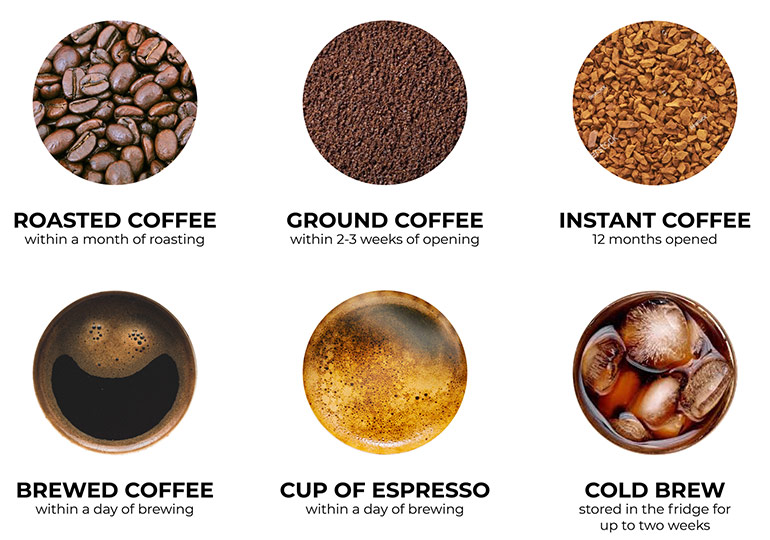Espresso is a beloved coffee choice. But how long does it stay fresh?
Espresso’s lifespan depends on several factors. Freshly brewed espresso will start losing its quality within minutes. The aromatic oils and flavors begin to fade quickly. So, it’s best to enjoy it as soon as possible. If left out, the taste changes and becomes bitter.
For storing espresso, the fridge is not ideal. It can last a few days, but it won’t taste the same. Freezing espresso is also not recommended. It loses its rich flavor profile. To truly enjoy espresso, drink it fresh. In this blog, we will explore how to keep your espresso at its best, and how storage impacts its quality. Ready to learn more? Let’s dive in!

Credit: mascolombia.com
Espresso Shelf Life
Espresso is a beloved coffee drink known for its rich flavor and aroma. But how long does espresso last? Understanding espresso shelf life helps you enjoy its best taste. Let’s explore some key aspects of espresso’s freshness.
Factors Affecting Freshness
Several factors influence the freshness of espresso. The type of beans used plays a significant role. Freshly roasted beans tend to last longer. Storage conditions are also crucial. Keep your espresso in an airtight container. Room temperature and humidity levels can impact the lifespan of your espresso. Always store in a cool, dry place.
Signs Of Expired Espresso
Knowing the signs of expired espresso can save you from a bad cup. One clear sign is a stale smell. Fresh espresso has a strong, pleasant aroma. Expired espresso often smells flat or musty. Taste is another indicator. Stale espresso tastes bitter or sour. Fresh espresso has a balanced, rich flavor.

Credit: thecoffeeaficionados.com
Storage Conditions
Proper storage conditions are essential for preserving the freshness and flavor of espresso. Storing espresso under the right conditions ensures that it retains its rich aroma and taste for as long as possible. Let’s explore the ideal storage conditions for your espresso.
Ideal Temperature
The temperature at which you store your espresso can greatly impact its longevity. Keep your espresso in a cool place. Avoid exposing it to direct sunlight or heat sources. The ideal temperature range is between 60°F and 70°F (15°C to 21°C). This prevents the oils in the coffee from going rancid.
Humidity Levels
Humidity plays a crucial role in maintaining the quality of espresso. Too much moisture can cause the coffee to absorb water, leading to a loss of flavor. Store your espresso in an airtight container to protect it from humidity. Aim for a humidity level of around 60%. This helps in preserving the freshness and prevents mold growth.
Storing Whole Beans
Storing whole beans correctly is crucial for maintaining the freshness of your espresso. The way you store your coffee beans impacts their flavor and aroma. Proper storage can extend the life of your beans, making each cup taste as good as the first.
Airtight Containers
Airtight containers are essential for keeping your coffee beans fresh. These containers prevent air from reaching the beans. Air exposure can make coffee beans stale. Using an airtight container will help preserve their flavor and aroma. Choose containers made of non-reactive materials like glass or stainless steel.
Cool, Dark Places
Store your coffee beans in a cool, dark place. Light and heat can degrade the quality of the beans. A pantry or a cupboard away from the stove is ideal. Avoid storing beans in the refrigerator or freezer. The moisture can cause damage to the beans. Keeping them in a dry, cool place ensures they stay fresh longer.
Storing Ground Espresso
Storing ground espresso properly is crucial to maintaining its flavor and aroma. Freshly ground espresso can lose its quality quickly if not stored correctly. The way you store your espresso can make a significant difference in how long it remains fresh and tasty. Here are some tips for both short-term and long-term storage.
Short-term Storage
For short-term storage, use an airtight container. This helps prevent air and moisture from affecting the coffee. Place the container in a cool, dark place, away from direct sunlight and heat sources. This helps maintain the espresso’s flavor.
- Use an opaque container to block light.
- Ensure the container has a tight seal.
- Store in a pantry or cupboard, not near the stove.
For best results, grind only the amount of espresso you need for immediate use. Freshly ground coffee loses its flavor faster than whole beans.
Long-term Storage
If you need to store ground espresso for a longer period, consider freezing it. Freezing can help preserve the coffee’s freshness for several months. Use a vacuum-sealed bag or an airtight container to prevent freezer burn.
- Divide the ground espresso into smaller portions.
- Place each portion in a vacuum-sealed bag.
- Label the bags with the date.
- Store in the coldest part of the freezer.
When ready to use, thaw the coffee at room temperature. Do not refreeze as this can degrade the quality.
Proper storage ensures your ground espresso stays fresh and flavorful, whether stored short-term or long-term.
Freezing Espresso
Freezing espresso can be a great way to preserve its rich flavor. It allows you to enjoy your favorite brew without compromising on taste. Proper techniques and methods are essential for the best results.
Proper Freezing Techniques
Start by brewing your espresso as you normally would. Once done, let it cool to room temperature. This step is crucial to prevent condensation. Pour the cooled espresso into an ice cube tray. Cover it with plastic wrap to avoid freezer burn. Place the tray in the freezer for several hours until solid.
For long-term storage, transfer the espresso cubes to a freezer-safe bag. Label the bag with the date to keep track. This method ensures that the espresso maintains its flavor.
Thawing Methods
To thaw frozen espresso, remove the desired number of cubes from the freezer. Place them in a glass or cup. Let them sit at room temperature until fully melted. This process can take a few hours. If you need it sooner, microwave the cubes for 10-15 seconds. Stir well to ensure even heating.
Another method is to place the cubes in the fridge overnight. This slower thawing process preserves the flavor better. Once thawed, the espresso is ready for use. You can enjoy it as is or reheat it slightly.
Impact Of Packaging
Packaging plays a crucial role in determining how long espresso lasts. Proper packaging can extend the freshness of your espresso. This section explores different packaging methods and their impact on espresso longevity.
Vacuum Sealed Bags
Vacuum sealed bags are effective for preserving espresso. They remove air, which slows down oxidation. This helps maintain flavor and aroma for a longer time. Vacuum sealing also protects against moisture and contaminants. It’s a popular choice for long-term storage.
Original Packaging
Original packaging is common for store-bought espresso. It often includes a one-way valve. This valve allows gas to escape without letting air in. It helps preserve the coffee’s freshness for a moderate time. However, once opened, the shelf life decreases. Transferring to an airtight container can help.
Using Expired Espresso
Expired espresso can still be used creatively. While its flavor might fade, it’s perfect for baking or cooking. Keep it stored in an airtight container for best results.
Many wonder if they can still use expired espresso. The short answer is yes, but with some caution. While the flavor and quality may not be the same, expired espresso can still serve many purposes.Potential Risks
Using expired espresso can pose some risks. The most common issue is stale taste. The rich flavor diminishes over time. This results in a less enjoyable cup. In rare cases, mold can grow in old espresso grounds. Consuming moldy coffee can lead to health problems. Always check for visible mold or a sour smell before use.Creative Uses
Expired espresso doesn’t have to go to waste. You can use it in various creative ways. One option is to use it as a natural fertilizer. Coffee grounds enrich the soil and help plants grow. You can also use expired espresso for cleaning. It works well as a scrub for pots and pans. Another idea is to use it in baking. Espresso can add a rich flavor to cakes and cookies. Or, make a coffee-scented scrub for your skin. It’s a great way to repurpose old espresso. “`
Credit: oliveyousomatcha.com
Expert Tips
When thinking about espresso, its freshness is key. Knowing how to keep it fresh can make a huge difference. Let’s explore some expert tips to ensure your espresso tastes great for longer.
Maximizing Freshness
Store your beans in an airtight container. This keeps out moisture and air. Place the container in a cool, dark place. Avoid storing beans in the fridge. It can cause condensation, which affects flavor. Grind your beans just before brewing. Freshly ground beans have the best taste. Use your espresso within two weeks of roasting. This is when the flavor peaks.
Avoiding Common Mistakes
Don’t buy beans in bulk. They lose freshness over time. Avoid using pre-ground coffee. It loses flavor quickly. Do not store beans in transparent containers. Light can degrade the quality. Never store beans near heat sources. Heat causes faster spoilage. Don’t leave the bag open. Oxygen ruins the flavor.
Frequently Asked Questions
How Long Does Brewed Espresso Last?
Brewed espresso lasts up to 12 hours at room temperature. However, it quickly loses its flavor and aroma. For best taste, consume it within an hour.
Can You Store Espresso In The Fridge?
Yes, you can store espresso in the fridge for up to 24 hours. It will lose its fresh flavor, though. Reheat carefully to avoid bitterness.
Does Espresso Go Bad?
Espresso doesn’t spoil but loses its quality over time. After 12 hours, it tastes stale and bitter. Freshly brewed is always better.
How To Tell If Espresso Is Stale?
Stale espresso tastes flat, bitter, and lacks aroma. Fresh espresso has a rich, complex flavor. Visual cues include a lack of crema.
Conclusion
Espresso freshness is key for a great taste. It lasts best when stored properly. Use airtight containers to keep it fresh. Consume within a week for top quality. Enjoy your espresso at its peak flavor. Stale espresso loses its charm and taste.
Now you know how to keep your espresso fresh. Follow these tips for the best coffee experience. Happy brewing!
